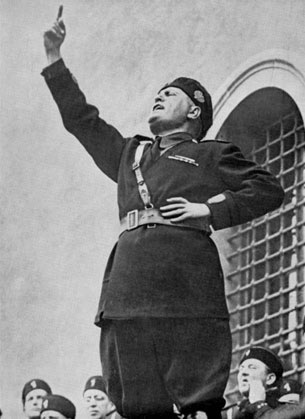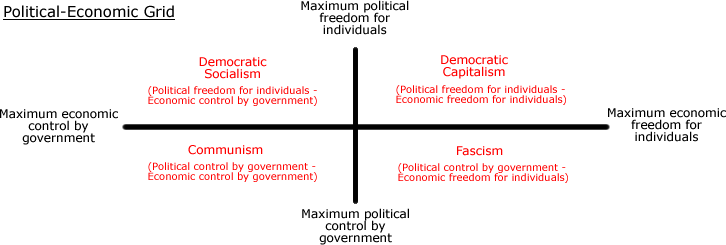Lesson Four: Fascism- Also Rejecting Classical Liberalism
| Site: | MoodleHUB.ca 🍁 |
| Course: | Social 30-2 RVS |
| Book: | Lesson Four: Fascism- Also Rejecting Classical Liberalism |
| Printed by: | Guest user |
| Date: | Monday, 27 October 2025, 8:19 AM |
1. Introduction
Fascism: Also Rejecting Classical Liberalism
Key Question: Is resistance to liberalism justified?
Duration: 3 blocks (80 mins each + homework)
Communism can be characterized as an ideology of the far left of the political spectrum, and fascism can be characterized as a ideology of the extreme right. During the 20th century (1900s), fascism's ideology was shared by the governments of Italy, Germany, Spain, and Japan. However, fascist movements were in evidence in Britain, France, and other European countries. Fascist policies also found supporters in the United States and Canada. On the political spectrum, fascism is located as shown below: What is fascism? Continue on to the lesson to learn about it!
2
2. 4.4.1 Fascism and the Rejection of Classical Liberalism
What is fascism? Watch this video and find out!
Guiding Principles of Fascism
Fascism has no single guiding philosophy or founding political theory. Rather, it is based on several powerful ideas as well as the fascist experience of the 20th century. Fascism is totalitarian dictatorship. That is, the government is controlled by a dictator, a person who through force has complete control over the lives of the people.
Go through this powerpoint to learn about how totalitarian dictators stay in power.
Techniques Dictators Use to Stay in Power
Benito Mussolini (1883-1945)
Mussolini, the Italian fascist dictator, is known as the originator of the political and economic system called fascism. In Italy, Mussolini was referred to in Italian as "Il Duce", meaning "the leader". He led Italy from 1922 to 1943 when he was overthrown. As an ideology, fascism is different from liberalism and communism in several significant ways. The most important values of fascism are unity and power.
The threat of a communist revolution in Italy brought about a harsh reaction from extreme conservative or right wing groups. Benito Mussolini and other ex-soldiers together with dissatisfied nationalists formed the first fascist groups in Italy.
Mussolini and the Italian fascists promoted ultranationalism in Italy with speeches, policies, and media propaganda. Opposition political parties were banned, and any dissent was crushed brutally by the fascists.

"Fascism is definitely and absolutely opposed to the doctrines of liberalism, both in the political and the economic sphere."
Now let's look at the fascist Economic-Political Spectrum Grid
Fascism can be placed on a spectrum grid that shows economic and political individual freedom or government control:

For more information on fascism you can read "Understandings of Fascism" on pages 172-174 of your textbook, Understandings of Ideologies. These pages will further your understanding of the concept of fascist rejection of liberalism.
You should make notes, either on paper or on your computer, about what you have read.
3. 4.4.2 Nazism and Hitler
Conditions that led to Nazi Germany's Rejection of Liberalism
Before World War I (1914-1918), Kaiser (king) Wilhelm II ruled Germany. Although Wilhelm was not an absolute monarch, he did not agree with democratic principles. After Germany was defeated in World War I in 1918, Wilhelm II abdicated. Germany adopted the principles of a liberal democracy, which included free and open elections and the freedom to establish and belong to any political party. The President was the head of state, and the Reichstag was their new parliament. However, the democratic Weimar Republic (the official name for Germany from 1919 to 1933) did not gain the trust of German citizens.
The government of the Weimar Republic failed to win the people's trust for two reasons
-
When WWI ended in 1918, Germany was left with no choice but to sign the Treaty of Versailles and to take the blame for having caused the war. As a result, the Allies forced Germany to pay reparations to European countries affected by the war. The German people were angry with their leaders for having signed the treaty.
-
Some economic issues angered the Germans. Suffering from a war-torn economy, the government printed more money to pay its debts. This action led to inflation and a rise in the price of goods.
However, the German government was able to restore confidence in the economy for a time. The United States loaned money to Germany to help it pay the required reparations. The German economy prospered until the Great Depression began in 1929. The Depression worsened significantly the economic situation for Germany. With the Great Depression, Germany spiralled into economic chaos. Add the crippling war reparations and a strong nationalistic desire and Germany had become vulnerable to any strong leader who wanted to take over the reigns of power.

Read "Setting the Stage for Fascism in Germany" on pages 174-176 of your textbook, Understandings of Ideologies. These pages will further your understanding of the concept of Nazi Germany's rejection of liberalism.
You should make notes, either on paper or on your computer, about what you have read.
4. 4.4.3 Review of Writing Assignment Type 1
In unit four lesson four you learned about fascism and the different techniques used by the fascist leaders of the 1930's to maintain power. In this lesson you will learn how to apply that knowledge to writing assignment type #1.
Here is a Reminder About Writing Assignment Type #1

This is super important information.
Writing Assignments Type #1 Are Fact Questions These types of questions will test your knowledge of specific concepts within all four related issues from the program of studies. In order to demonstrate your knowledge you will be required to sort that knowledge and attach value.
Suggestions for Success
- You will be given a visual prompt of either a jigsaw puzzle, blocks. webs, etc
- The material given will ask you to sort out what is the correct material and what is the incorrect material
- I would recommend you create a T-Chart like the one below to help you sort the information. If there is information that you do not recognize, put it to the side. When you are done sorting the information you know, go back and see if the missing information makes more sense to you. If not, DO NOT use it in your response
|
Terms that Apply to Democracies |
Terms that Apply to Authoritarian Governments |
|
· Rule of law
|
·
Fear and terror |
- You will be expected to write about what you know and PLEASE ignore any terms that you do not know; if you cannot recognize the meaning of the prompts, you are better off using your own knowledge and not using the prompts at all
- You may write about one characteristic or a selection of a few characteristics (my personal recommendation would be to write on TWO or THREE of the terms maximum). You may also explain why the incorrect concepts are wrong, so you can demonstrate your understanding by writing off the wrong information
- When you are explaining the importance of a concept use either a HISTORICAL OR CONTEMPORARY example in your discussion. For example, if the question asks you about the most important characteristics of an authoritarian government you should talk about either Stalin, Hitler or Mussolini
What is the purpose of this assignment anyway? When you are asked to explain your choices you are attaching value, and demonstrating critical thinking skills. This is where you can bring in your knowledge of social studies.
Please print the handout How to Write Assignment Type #1 Guide.
5. Conclusion
Fascists proposed that individuals should not be treated as equals, because they believed that some people are weaker than others. They also embraced the idea that humans and nations are in competition with one another for survival. Fascism, which arose in opposition to liberalism and communism, emphasizes the importance of the state and proposes that individuals sacrifice their self-interests for the good of the state. An extreme and militaristic nationalism was key to fascism, sometimes leading the way to genocide. Loss of individual rights is enforced by a dictatorial state led by a dictator exerting total control over people's political and economic lives. The rise of fascism in the 20th century is, in part, a response to the belief that liberalism was unable to address the needs of citizens in times of suffering after the First World War and during the Great Depression.

Hitler and Mussolini
Now that you have finished learning about ideologies that developed in response to classical liberalism you might enjoy this:
Socialism |
If you have two cows, you give one to your neighbor. |
|---|---|
| Communism | If you have two cows, you have to take care of them but the government gets all the milk. |
| Fascism | If you have two cows, you keep the cows and give the milk to the government; then the government sells you some of the milk. |
| New Dealism | If you have two cows, you shoot one and milk the other; then you pour the milk down the drain. |
| Nazism | If you have two cows, the government shoots you and keeps the cows. |
| Capitalism aka Classical liberalism (where it all started) |
If you have two cows, you sell one and buy a bull. |
